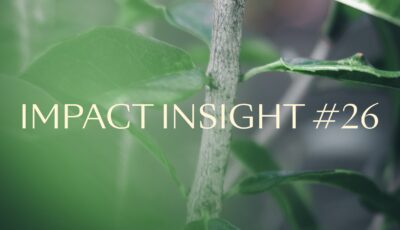Top 5 Impact Investing Trends to Watch in 2023

As impact investing gains momentum, the industry is poised for exciting developments in the coming year. At Norselab, we've been keeping a close eye on the latest trends and predictions for impact investing; here is our take on what to expect from the impact year 2023.
1. Product-driven impact will break through as the new standard for impact investing
The past year exposed the widespread confusion around ESG. While both professionals and consumers thought they were “investing for good” by putting their money into ESG funds, it is now becoming clear to many that considering the operational aspects of investments is not enough to bring about real changes in the world.
This year, we expect to see product-driven impact emerge as the new standard for impact investing. Impact investors will no longer ask only how companies do things, but what they do.
When focusing on impactful products and services - versus mainly considering how the company operates - there is no conflict between a company’s commercial success and its positive impacts. Economists talk about unit economics; impact professionals will be looking for unit impacts.
This perspective also transpires in the discussion sparked by the recent wave of fund downgrades from Article 9 (the EU’s “greenest” funds) to the less stringent Article 8. Morningstar’s global director of sustainability research, Hortense Bioy, recently stated to Bloomberg that Article 9 will “clearly” shrink and be limited to “thematic and impact-oriented funds investing in companies that focus on sustainable products and services.”
2. New records in the impact investing market
Last year was a turning point for impact investing, as it topped the $1 trillion mark while ESG funds experienced outflows for the first time in a decade.
Investors’ understanding of the sustainable investing spectrum is maturing. Amidst the ESG polemic, the energy crisis sparked by the Ukraine war, a wave of new regulations such as the EU’s SFDR, the US’ Inflation Reduction Act and the EU’s matching Green Deal Industrial Plan, alongside increased general awareness of the climate emergency, investors are looking to impact strategies.
The idea of "concessionary returns" for impact investing is being debunked by a growing number of asset managers, who believe that the best long-term investment opportunities will be in companies that help build a sustainable tomorrow. This shift in perceptions is helping to drive broader adoption of impact investing, as investors recognize the potential for both financial returns and impact outcomes.
3. After climate, biodiversity will become the next big buzz
“Climate change”, “decarbonization”, “net zero”. These terms have all entered the mainstream. And although we agree there is still a long way to go to curb emissions and fight climate change, climate investments have gained some serious momentum. A recent report by PwC found that climate tech funding in 2022 represented more than a quarter of every venture dollar invested that year.
Many consider that biodiversity had its “Paris moment” with the agreement concluded at COP15. This is already drawing attention to the interconnectivity of climate and biodiversity, and will certainly spark an overall broadening of environmental themes investors will focus on.
There are already several initiatives designed for finance to start addressing biodiversity. 150 financial institutions managing more than USD 24 trillion have signed the Finance for Biodiversity Pledge, which commits them to protecting and restoring biodiversity through their financial activities and investments.
We expect that the spotlight on biodiversity will trigger asset managers to explore the investment opportunities that lie in preserving and protecting nature, and start building a momentum similar to the one we’re currently seeing on climate.
Among the initiatives that will bring clarity to the space are the forthcoming EU Taxonomy’s environmental objectives, the draft Guidelines from the World Business Council for Sustainable Development, the draft Task Force on Nature-related Financial Disclosures, and the Science-Based Targets for Nature.
4. Will downgrades to Article 6 be next up after the wave of downgrades from Article 9 to Article 8?
The increased push for disclosures and intensified legal scrutiny over sustainability claims will continue to give asset managers cold feet about their SFDR Article 9 categorization. Going back 12-18 months, many funds rushed towards the Article 9 categorization, expecting that regulators would be lenient in their requirements. Many sustainability professionals worried - rightly - that the EU’s SFDR and Taxonomy Regulation would be yet another vehicle for greenwashing. However, recent developments suggest that Article 9 will only be reserved y for funds that intentionally contribute to sustainability.
In 2023, we will see expectations crystallize not only for Article 9, but also for Article 8 funds. After the flood of downgrades from Article 9 to Article 8, a similar wave of downgrades to Article 6 might be looming in 2023. This could have severe ripple effects for managers, as affected funds lose the possibility to make sustainability claims, and they would likely lose ESG clients.
As attractivity for Article 9 grows among investors, and Article 8 is perceived a minimum requirement for ESG investors, this shift might also spark the change the EU aimed for (and the one we hope for!); that asset managers up their sustainability game to comply with the requirements for Article 8 or 9.
5. Impact as an all-encompassing mindset, not a separate asset class
Could 2023 be the year that asset managers start considering impact as a lens to apply across all investment activities and not as a separate asset class?
At least, we believe there will be more new, purpose-built asset managers in the impact space. They spring from the fundamental belief that companies that substantially contribute to creating a meaningful future offer the very best investment opportunities, no matter the asset class.
At Norselab, we are dedicated to proving that impact is the future of investing across asset classes. With the support of Capricorn's Sustainable Investors Fund, we're already off to a strong start in venture capital, where we have three funds, and are now expanding into credit with the first Nordic Impact High Yield Fund with an Article 9 categorization.
As we scale up, you can expect to see us expand into new asset classes, always with our impact lens - “Meaningfulness” - at the core. To us, venture capital offers the opportunity to build the impact of native companies that are shaping our tomorrow. This is obviously very exciting because we can back companies that solve sustainability challenges from the beginning. However, to drive meaningful change where it's urgently needed, we must also tackle established industries and accelerate their transition. This is what we do with our High Yield credit fund, and it is a path that we will continue to explore with new fund initiatives.
Time for a race to the top
We are optimistic about the outlook for impact investing in 2023, and the coming years. Eventually, it should become embedded in everything investors do. After several years of what may have felt like stealth mode, with sustainability initiatives moving forward in slow motion, we are finally seeing substantial movement among regulators, investors, and the general public. Let’s make it a race to the top!


